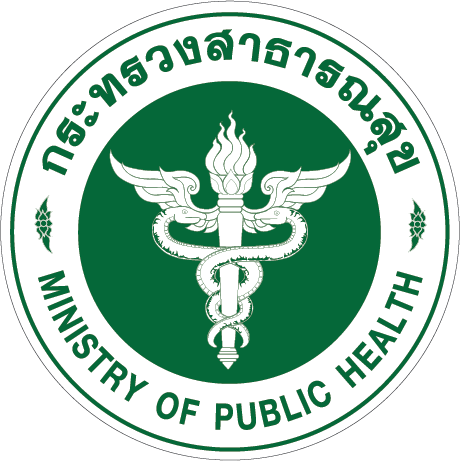Effects of a Program to Promote Medication Adherence Using Telepharmacy in Chronic Disease Patients Pa Sang Hospital, Lamphun Province
Keywords:
medication use promotion, medication adherence, telepharmacy, hypertensionAbstract
Background: From the World Health Organization report revealed that various chronic diseases encountered all over the world was a big problem that’s getting more and more serious and be is a major public health problem. Therefore, a study of medication use promotion programs was developed to strengthen the use of medicines by patients with chronic diseases who are serviced through telepharmacy.
Objective: The main objective was to compare the results before and after using the this program on medication adherence and the secondary objectives were to assess medication use behavior, patient’s behavior and self-care and home medication use problems at home.
Methodology: The study was a quasi-experimental research. Study was conducted between September and December 2022 with a total of 202 hypertensive patients, a chronic disease representative, participating in the medication delivery program with telepharmacy.
Results: Comparisons before and after using the program showed that: the mean±SD of cooperation in medication use by Morisky Medication Adherence Scale (8 full score) was significant increased from 6.18±0.95 to 7.36±0.79 (p<0.05), home medication use behavior (5 full score) from 3.60±034 to 4.06±0.57 (p<0.05), patient’s behavior, and self-care at home (5 full score) from 3.34±0.39 to 3.49±0.34 (p<0.05) and home medication use problems (5 full score) were decreased from 1.89±0.62 to 1.45±0.32 (p<0.05)
Conclusion: A telepharmacy medication promote program produces positive outcomes for chronic disease patients. This includes promoting knowledge, cooperation, correct medication use behavior, patient’s behavior and self-care and reduce home medication use problem.
References
อดุลย์ บัณฑุกุล. คู่มือโรคเรื้อรัง. กรุงเทพฯ: กลุ่มศูนย์การแพทย์เฉพาะทางด้านอาชีวเวชศาสตร์ฯ โรงพยาบาลนพรัตนราชธานี. 2561.
World Health Organization. Improving access to treatment for chronic diseases [Internet]. Geneva: World Health Organization; 2020 [cited 2022 Jul 4]. Available from: https://www.who.int/news-room/feature-stories/detail/improving-access-to-treatment-for-chronic-diseases
เนติมา คูนีย์. การทบทวนวรรณกรรม: สถานการณ์ปัจจุบันและรูปแบบการบริการด้านโรคไม่ติดต่อเรื้อรัง [อินเทอร์เน็ต]. กรุงเทพฯ: สถาบันวิจัยและประเมินเทคโนโลยีทางการแพทย์ กรมการแพทย์ กระทรวงสาธารณสุข. 2557 [สืบค้นเมื่อ 20 เมษายน 2565]. สืบค้นจาก: http://www.imrta.dms.moph.go.th/imrta/images/doc20141107.pdf
สำนักงานกองทุนสนับสนุนการสร้างเสริมสุขภาพ (สสส.). โรคเรื้อรังคุกคามคนไทย. กรุงเทพฯ: สำนักงานกองทุนสนับสนุนการสร้างเสริมสุขภาพ (สสส.); 2563.
โรงพยาบาลป่าซาง จังหวัดลำพูน. รายงานข้อมูลผู้ป่วยโรคเรื้อรังรายใหม่ที่เข้ารักษาที่โรงพยาบาลป่าซาง จังหวัดลำพูน ปีงบประมาณ 2562 – 2564. ลำพูน: โรงพยาบาลป่าซาง จังหวัดลำพูน; 2565.
จิราพร ลิ้มปานานนท์, วรวิทย์ กิตติวงศ์สุนทร, รุ่งเพ็ชร สกุลบำรุงศิลป์, วิไลลักษณ์ ตันตะโยธิน, กุลวดี ศรีพานิชกุลชัย, นุศราพร เกษสมบูรณ์ และคณะ. การพัฒนาแนวทางการดำเนินงานบริการเภสัชกรรมทางไกล (telepharmacy) ในประเทศไทย. กรุงเทพฯ: สถาบันวิจัยระบบสาธารณสุข (สวรส.); 2564.
วริษา ณ ลำปาง. ความก้าวหน้าของ telepharmacy ที่มีผลกระทบต่อการให้บริการเภสัชกรรม แบบ new normal ในประเทศไทย [วิทยานิพนธ์ปริญญาการจัดการมหาบัณฑิต]. กรุงเทพฯ: มหาวิทยาลัยมหิดล; 2564.
สภาเภสัชกรรม. ประกาศสภาเภสัชกรรม ที่ 56/2563 เรื่อง การกำหนดมาตรฐานและขั้นตอนการให้บริการเภสัชกรรมทางไกล (telepharmacy) [อินเทอร์เน็ต]. กรุงเทพฯ: สภาเภสัชกรรม; 2563 [สืบค้นเมื่อ 20 เมษายน 2565]. สืบค้นจาก: https://www.pharmacycouncil.org/index.php?option=content_detail&menuid=68&itemid=1846&catid=0
โรงพยาบาลป่าซาง จังหวัดลำพูน. โครงการให้บริการผ่านระบบบริการเภสัชกรรมทางไกล (telepharmacy). ลำพูน: โรงพยาบาลป่าซาง จังหวัดลำพูน; 2565.
Morisky DE, Ang A, Krousel-Wood M, Ward HJ. Predictive validity of a medication adherence measure in an outpatient setting. J Clin Hypertens (Greenwich). 2008;10(5):348-54. doi: 10.1111/j.1751-7176.2008.07572.x.
ศิริพร พรหมรัตน์, พนิตา ค้าผล, ณัฏฐิญา ค้าผล. ผลของโปรแกรมสร้างความร่วมมือในการใช้ยาโดยใช้เภสัชกรรมทางไกลในผู้ป่วยความดันโลหิตสูง. ไทยไภษัชยนิพนธ์. 2564;17(1):31-41.
ชนานุช มานะดี. ผลการดูแลผู้ป่วยสูงอายุโรคเรื้อรังด้านการใช้ยาที่บ้านในเขตโรงพยาบาลส่งเสริมสุขภาพตำบล อำเภอสมเด็จ จังหวัดกาฬสินธุ์. วารสารเภสัชศาสตร์อีสาน. 2557;10(3):354-371.
Poudel A, Nissen LM. Telepharmacy: a pharmacist's perspective on the clinical benefits and challenges. Integr Pharm Res Pract. 2016;5(8):75-82. doi: 10.2147/IPRP.S101685.
Sungsana W, Nakaranurack C, Weeraphon B, Charoenwaiyachet W, Chanprasert S, Torvorapanit P, et al. Telepharmacy during home isolation: drug-related problems and pharmaceutical care in COVID-19 patients receiving antiviral therapy in Thailand. J Pharm Policy Pract. 2023;16(1):29. doi: 10.1186/s40545-023-00538-z.
Rocha PA, Toma TS. Use of telepharmacy for the care of people with chronic communicable diseases. Research, Society and Development. 2023;12(3):287-98.
สภาเภสัชกรรม. ประกาศสภาเภสัชกรรม ที่ 62/2565 เรื่อง แนวทางเกี่ยวกับมาตรฐานการให้บริการเภสัชกรรมทางไกล (telepharmacy) [อินเทอร์เน็ต]. กรุงเทพฯ: สภาเภสัชกรรม; 2565 [สืบค้นเมื่อ 20 เมษายน 2565]. สืบค้นจาก: https://www.pharmacycouncil.org/index.php?option=content_detail&menuid=68&itemid=2966&catid=0

Downloads
Published
How to Cite
Issue
Section
License
Copyright (c) 2023 Health Administration Division, Office of the Permanent Secretary, Ministry of Public Health and The Society of Hospital Pharmacist, Ministry of Public Health

This work is licensed under a Creative Commons Attribution-NonCommercial-NoDerivatives 4.0 International License.
ข้อความภายในบทความที่ตีพิมพ์ในวารสารเภสัชกรรมคลินิกทั้งหมด รวมถึงรูปภาพประกอบ ตาราง เป็นลิขสิทธิ์ของกองบริหารการสาธารณสุข สำนักงานปลัดกระทรวงสาธารณสุข และ ชมรมเภสัชกรโรงพยาบาลกระทรวงสาธารณสุข การนำเนื้อหา ข้อความหรือข้อคิดเห็น รูปภาพ ตาราง ของบทความไปจัดพิมพ์เผยแพร่ในรูปแบบต่าง ๆ เพื่อใช้ประโยชน์ในเชิงพาณิชย์ ต้องได้รับอนุญาตจากกองบรรณาธิการวารสารเภสัชกรรมคลินิกอย่างเป็นลายลักษณ์อักษร
กองบริหารการสาธารณสุข สำนักงานปลัดกระทรวงสาธารณสุข และ ชมรมเภสัชกรโรงพยาบาลกระทรวงสาธารณสุข อนุญาตให้สามารถนำไฟล์บทความไปใช้ประโยชน์และเผยแพร่ต่อได้ โดยอยู่ภายใต้เงื่อนไขสัญญาอนุญาตครีเอทีฟคอมมอน (Creative Commons License: CC) โดย ต้องแสดงที่มาจากวารสาร – ไม่ใช้เพื่อการค้า – ห้ามแก้ไขดัดแปลง, Attribution-NonCommercial-NoDerivatives 4.0 International (CC BY-NC-ND 4.0)
ข้อความที่ปรากฏในบทความในวารสารเป็นความคิดเห็นส่วนตัวของผู้เขียนแต่ละท่านไม่เกี่ยวข้องกับกองบริหารการสาธารณสุข สำนักงานปลัดกระทรวงสาธารณสุข และ ชมรมเภสัชกรโรงพยาบาลกระทรวงสาธารณสุข และบุคลากรในกองฯ หรือ ชมรมฯ แต่อย่างใด ความรับผิดชอบองค์ประกอบทั้งหมดของบทความแต่ละเรื่องเป็นของผู้เขียนแต่ละท่าน หากมีความผิดพลาดใด ๆ ผู้เขียนแต่ละท่านจะรับผิดชอบบทความของตนเอง ตลอดจนความรับผิดชอบด้านเนื้อหาและการตรวจร่างบทความเป็นของผู้เขียน ไม่เกี่ยวข้องกับกองบรรณาธิการ



